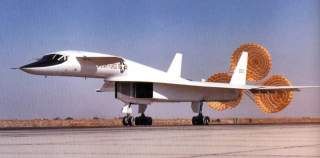Watch an XB-70 Valkyrie Mach 3 Bomber Perform an Emergency Landing
What went down.
The B-70 Valkyrie, with a planned cruise speed of Mach 3 and operating altitude of 70,000 feet, was to be the ultimate high-altitude, high-speed manned strategic bomber. Events, however, would cause it to play a far different role in the history of aviation.
By the early 1960s in fact, new Surface-to-Air Missiles (SAMs) threatened the survivability of high-speed, high-altitude bombers, while less costly, nuclear-armed ICBMs (Intercontinental Ballistic Missiles) were also entering service. As a result, in 1961, the expensive B-70 bomber program was canceled before any Valkyries had been completed or flown.
Even so, the USAF bought two XB-70 aircraft to test aerodynamics, propulsion and other characteristics of large supersonic aircraft. The first XB-70A (Air Vehicle 1 or AV 1) flew in September 1964, and it achieved Mach 3 flight in October 1965. The second Valkyrie (AV 2) first flew in July 1965, but in June 1966, it was destroyed following an accidental mid-air collision. The third Valkyrie (AV 3) was not completed.
AV 1 continued to fly and generate valuable test data in the research program until it was brought to the National Museum of the U.S. Air Force in 1969. As we have already explained on Mar. 7, 1966 the aircraft had to perform an emergency landing on “tip-toe”following hydraulic problems.
Not to outdone, AV 2 also experienced a landing gear problem — this time on Apr. 30, 1966 the 37th flight. Shortly after takeoff, Joe Cotton retracted the landing gear. However, as told by Graham M. Simons in his book Valkyrie: The North American XB-70- The USA’s Ill-Fated Supersonic Heavy Bomber, a short-circuit in the landing gear retraction system permitted wind forces to blow the nose gear back into the partially-retracted gear well door, slashing the tires. An attempt to lower the gear using the normal hydraulic system failed. Trying the backup electrical system, Cotton heard a ‘pop’ as that system went dead.
Al White first brought the XB-70 around for a touch-and-go, hoping that a hard impact on the main gear would knock the nose gear loose and let it fall to the extended position. Even after a second try, however, the nose gear remained jammed. At this point, bailing out and losing the aircraft was quickly becoming the only option.
But there was fuel to burn, so White and Cotton circled around Edwards while engineers on the ground attempted to sort things out and come up with a solution. After more than two hours the problem with the backup system was traced, so they hoped, to a circuit breaker. Now all Cotton had to do was find a way to short circuit the unit. Of course, the Valkyrie had no onboard toolkit — that would have made things too simple. But Cotton had brought along his briefcase with his various notes and plans, and opening it, he found a binder-type paperclip. Straightening out the paperclip, then grasping the middle of it with a leather glove. Cotton carefully reached in and short circuited the breaker.
It did the trick.
However, the malfunction also caused hydraulic pressure to remain on three of the four main wheel brakes, which were thus locked when the aircraft landed at 173 knots. Fire fighters at Edwards prevented any serious damage to the aircraft, which flew again a little over two weeks later.
The following video shows AV 2 coming to a halt on the main runway at Edwards AFB after the so called “paperclip flight” described in this article.
This first appeared in Aviation Geek Club here.
Image: Creative Commons.

